The best of these tales comes
from Ipswich, in Essex County, Massachusetts, which is an ancient New
England sea town. It was founded in 1633 by John Winthrop and twelve
partners – a witch’s number – as a semi-military post to keep the French
away, and its roots are deep in the grim and unyielding Old Testament
Puritanism of that early age.
Like all good Devil stories,
this one tales place in a church, and a famous
church at that. When the Winthrop Thirteen came to Ipswich,
"upon ascending the hill above the river they found an outcropping ledge
of goodly extent, forming a sort of natural platform, and upon this rock
they built their church." This church, known as The First Church of
Ipswich, subsequently became famous throughout the Colony for the
learning and piety of its ministers, not to mention their Devil-wresting
skills.
The story unfolds in 1740 on
October’s Eve, September 30th. A traveling preacher, the
Rev. George Whitefield, was on a thunder-and-brimstone tour of New
England and made the fate-filled move of unleashing a sermon of
unparalleled intensity in First Church on the high ledge in Ipswich.
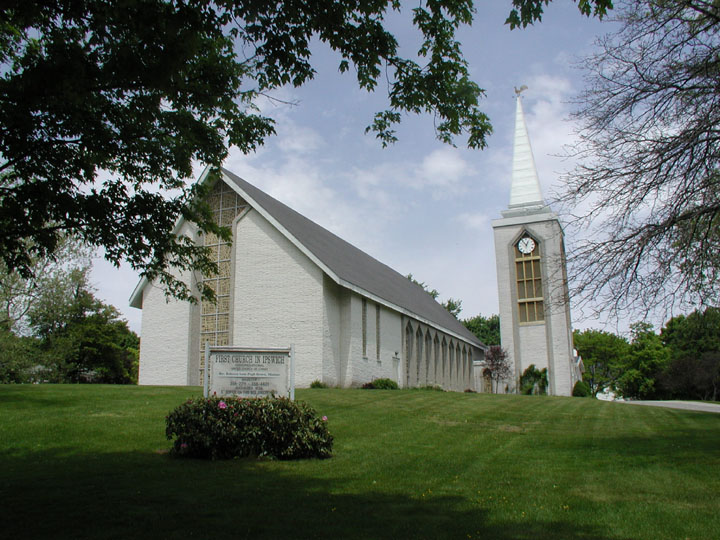
The First Church of Ipswich
The original structure burned and was
rebuilt
Some things will never be
completely understood. For instance, why was there an enormous curved
mirror behind the pulpit in First Church? And why did the Devil live in
that mirror?
However it may be, the
congregation had no choice but to contemplate their own reflections in
the distorting effects of the primitive looking-glass while the grim
words of Puritanism rolled over them every Sabbath. Not a situation to
improve anyone’s demeanor.
Consider too that the Devil, for
reasons known only to himself, had previously taken up residence in said
mirror. Was this mirror-dwelling Devil the projected Shadow Self of the
congregation, projected there under the toil and labors of the mighty
roiling fist of eye-for-an-eye Puritan pulpit-pounding? That
explanation is far too Jungian. I prefer to think that His Satanic
Majesty had a furnished condo in there and the mirror was his picture
window on the world. Like most monarchs, he liked to keep an eye on
things.
On that October Eve our
mirror-ensconced fiend sure got an eye and ear-full. The Rev.
Whitefield was in rare form and unleashed a tremendous sermon, hitting
all the high notes. He thundered, he gave long dramatic pauses, and
issued the most dire proclamations on the soul, urging repentance,
renunciation, and the giving up the ways of the world.
This was apparently more then
any right-minded Devil could take. Old Scratch burst out of the mirror
in a bang and a flash (the mirror went unscathed) and took furious form
among them in full regalia of horns and tail and hooves, much as he was
wont to do in those days.
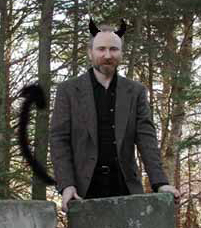
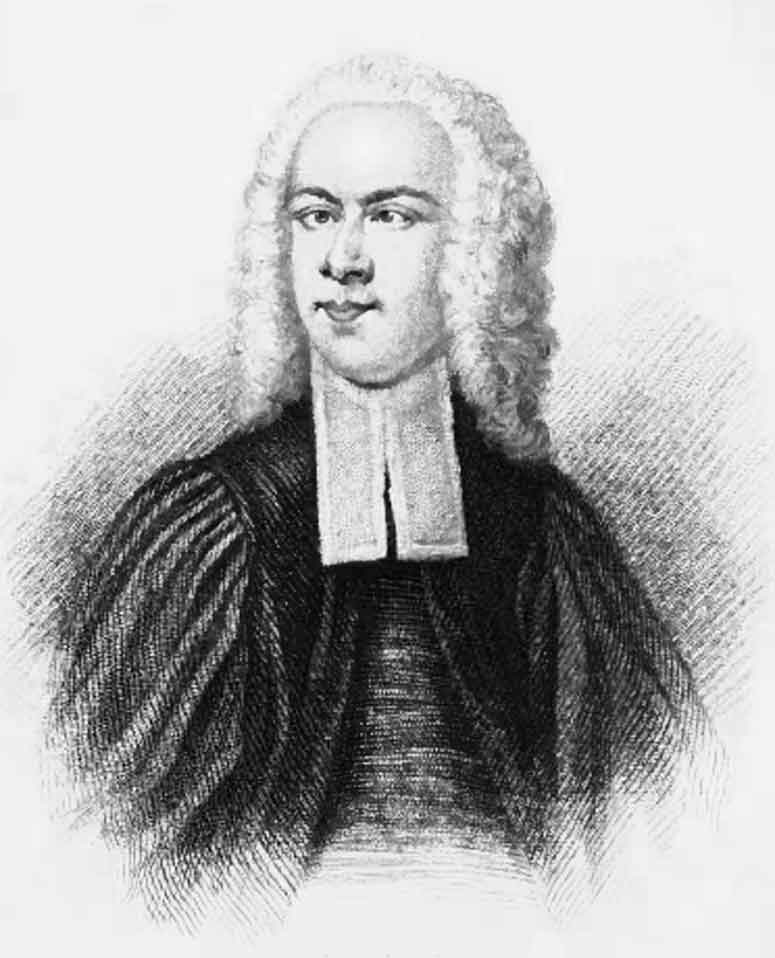
The Devil vs. George Whitefield
George Whitefield was cross-eyed
The Devil is all class in that coat
But Whitefield, although a young
man, was a tough and canny man and was not taken aback by such cheap
theatrics. In fact, the Devil could scarcely have found himself a more
powerful opponent had he tried. The Rev. George Whitefield, enshrined
in history as "the first modern celebrity," was the leading figure of
the Great Awakening, the first of several sweeping, dramatic revivals of
religion and Protestant reformation in America. More impacting than
even John Wesley, the English-born Whitefield routinely preached to
crowds in the tens of thousands, a fact verified by a skeptical Ben
Franklin.
Although only 26 years old at
the time, the young founding Methodist was a
veteran of aggressive evangelism, and simply grabbed the Devil
and slammed him to the mat. They wrestled like maniacs on the floor and
eventually rolled clawing and punching outside into the churchyard.
Squaring off again, the young Church of England minister was slowly
forced little by little up the side of First Church and onto the roof.
They pushed and shoved each
other back and forth across the roof, trying to cast each other off into
destruction, while the congregation watched in horrified amazement,
rooted to the spot. Perhaps it was the wily moves of the Devil, or a
situation where Whitefield’s cross-eyed condition was detrimental to
close quarter Devil-wrestling, but once again the young orator was
forced back further and higher, this time up the very steeple.
Inch by inch they fought, with
Whitefield backing further up the steeple until they battled at the very
pinnacle. With nowhere left to go, Whitefield drew on his massively
commanding voice, a voice which could carry to crowds in the tens of
thousands. No one knows what mighty words he spoke, only that it
blasted forth from him like a trumpet, and that he emphasized his Lion’s
Roar with a mighty push.
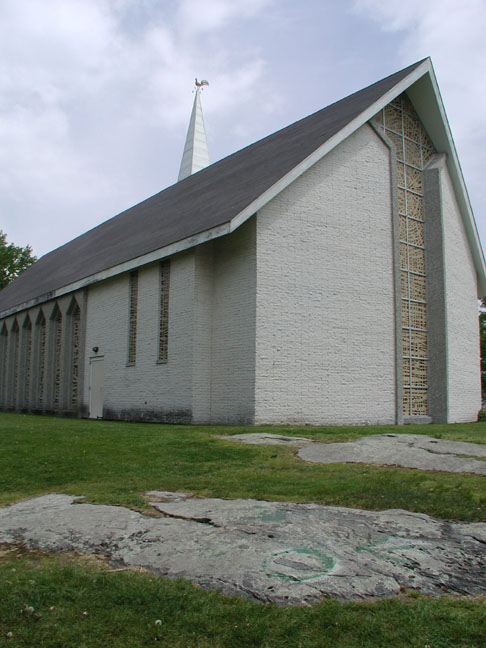
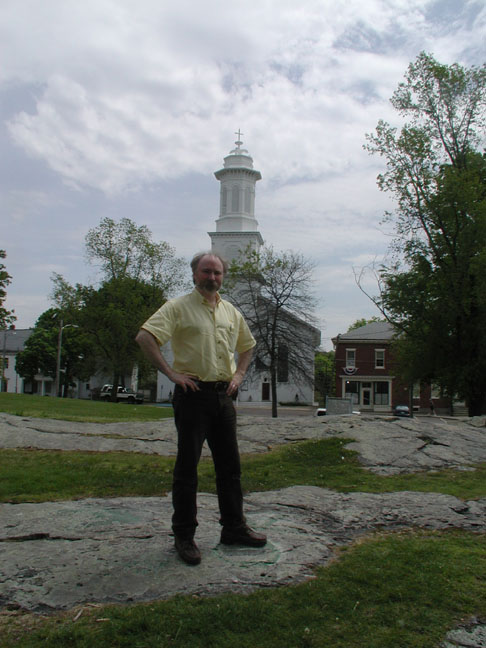
Devil's Footprint is circled in green
on the ledge rock
The author surveys the situation
Old Scratch was hurled in a
flinging leap off the steeple, landing like a cat on his feet in the
rocky ledge below. He scrambled down the hill in terrified leaps and
bounds, never to return. But where his feet had struck the ledge there
"smoldered the indelible print of Satan’s cloven hoof."
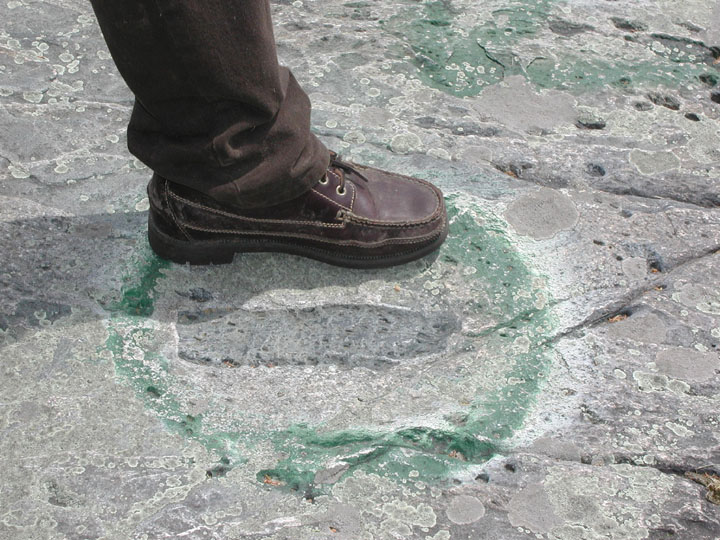
My shoe matches Devil's Footprint -
coincidence?
Photo credit: Scurv Dawg
Rev. George Whitefield climbed
down and dusted himself off, gave thanks to God, and the meeting
resumed. He was a humble man, and all his journal for the day recorded
was, "Tuesday, Sept. 30 [1740] Preached at Ipswich about 10 in the
morning, to some Thousands; the Lord gave me Freedom, and there was
great Melting in the Congregation."
The Devil was sticking his foot
into things more successfully in Norton, Massachusetts, in 1716, long
before mixing it up with Whitefield in Ipswich.
It all starts with a Man of God, as is usual
in these cases. (The Devil doesn’t seem to care about the rabble; they
get by all right on their own.) This particular Man of God was the
Deacon Major Thomas Leonard, who emigrated from Wales to Plymouth,
Massachusetts, prior to 1662. Deacon Leonard was a vain man and claimed
descent from a noble family in England, an unfortunate conceit that was
passed on to his young son, Major George Leonard, who was born in 1670.
Young George lusted for the
wealth and estates rightly due his alleged noble English heritage. So
much so that as a young man, it is said, that one night when he met a
man all in black in the primeval forests of New England, he was ready to
hear his pitch. It was a simple proposition. George would be wealthy
beyond imagining all the days of his life, for only the price of his
soul, which the Man in Black said he would collect himself bodily upon
George’s demise.
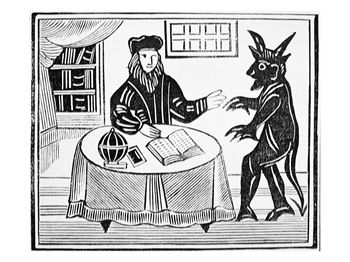
Artists Conception of George Signing a
Pact
Now George didn’t advertise this
little business deal, but what did get around was the sudden and
wondrous upsurge of his fortunes. Not only did he marry the beautiful
Anna Tisdale in 1695 at the age of 25, but he became "very wealthy and
owner of the largest landed estate in New England," according to
historian Ellery Bicknell Crane. Ellery does not tell us how this was
accomplished, but you and I both know it had something to do with a
little piece of parchment signed in blood in the depths of the forest
one dark night in George’s youth.
Young and wealthy, George
Leonard built the first frame house in Norton, the country seat of his
new estates and settled there with his young bride. The house became
known as the Leonard Mansion as many additions and renovations occurred
over the ensuing years.
Now the Devil (for that is who
the Man in Black was) had granted George wealth and estates for all the
days of his life. But the actual length of those days was unspecified,
which is an important point any of you at home need to bear in mind if
ever you find yourself in a similar situation. What happened was that
George died in 1716, at only 46 years old, with a scant 21 years of
living it up under his belt.
Did he choke on a chicken bone?
History is silent on the cause of his demise. All we know from the
stories that have swirled across the years is that poor George was
forthwith laid out in an upstairs room of the Leonard Mansion. His wife
Anna and their nine children (they’d been a busy couple) gathered
downstairs in the parlor with friends and relations to mourn his
untimely passing.
Amid the sobs and condolences during that long night, a horrible racket
was suddenly heard from the upstairs room. The family ran upstairs and
Anna burst open the door on a truly horrible sight. There in the room
was the Devil himself, come to collect George. His eyes blazed red, and
with a horrible laugh he tucked George’s body under his arm and jumped
out the open window. The black-clad figure landed on a large boulder
below, and bounded off into the night shrieking with triumph and
trailing the smell of brimstone behind him. A single parchment
fluttered to the floor of the room. Anna burnt it.
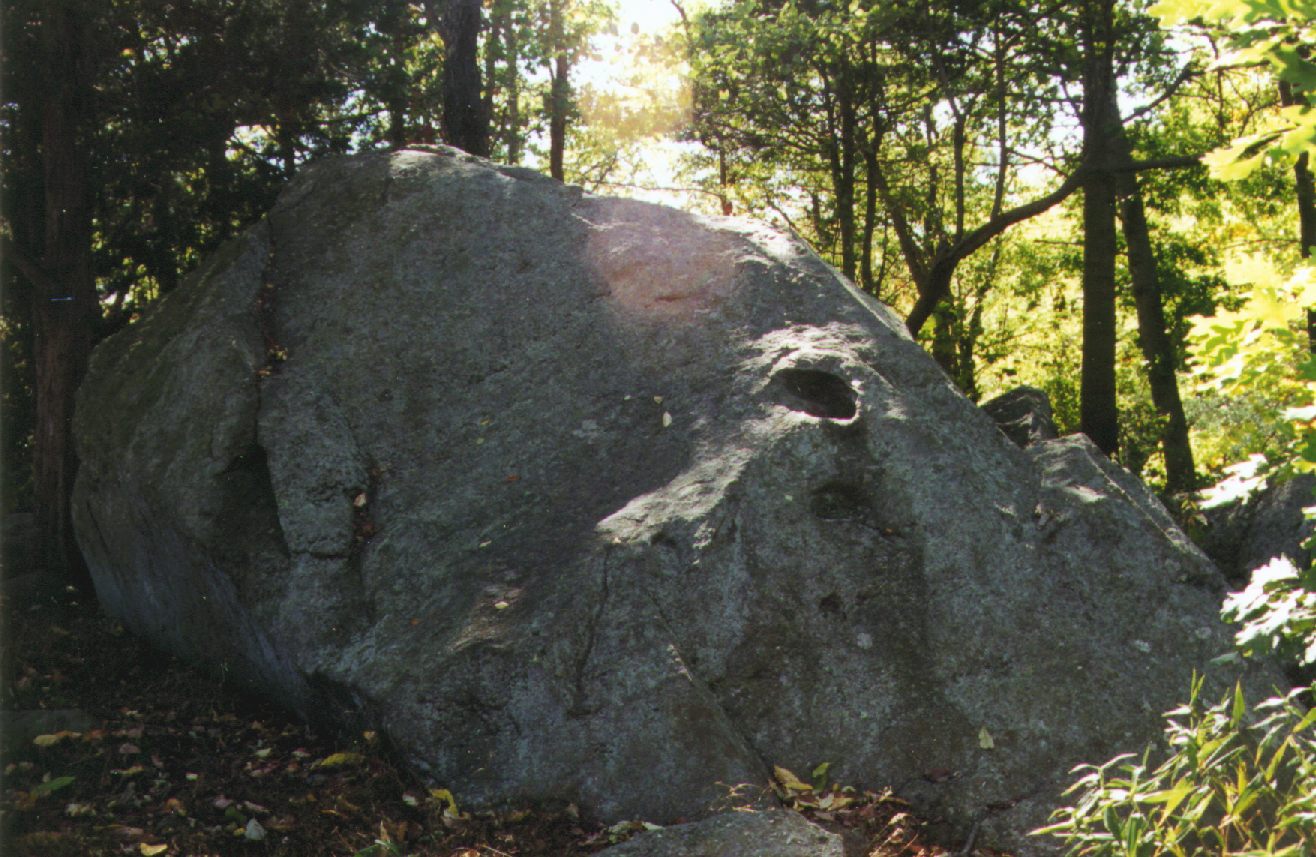
Devil's Footprint, Norton Massachusetts
Photo courtesy of Jim Moore
The next day it was noted that
the boulder was marked with a deep impression of the Devil’s infernal
foot and remains so marked to this day. George’s family put an oak log
in his coffin to make up for the weight and hurriedly conducted a
burial. Anna was badly shaken and did not remarry for 14 years,
preferring to live as a wealthy woman of her
own account. But George’s namesake son and grandson went on to
considerable fame, building on the fortune they inherited from Old
George’s secret deal.
George Leonard Jr.
rose to the rank of Colonel in the militia and was appointed a Judgeship
in 1725. In a touch of the old taint he was dismissed from the bench in
connection with the notorious Land Bank scheme, but was reinstated six
years later as Chief Justice. He lived to be 83 years old.
George Jr.’s son,
George Leonard III, graduated from Harvard, practiced law, and became a
Chief Justice like his
father. He was a member of the Provincial Assembly during the
Revolutionary War, and served in both the State House of Representatives
and the State Senate, and was also elected to Congress. Like his father
he also lived to a ripe old age, being 90 years old when he died.
This suggests that when it comes
to lawyers and politicians, the Devil watches over his own. But no one
was watching over the old Leonard Mansion. By 1960 it was in poor
condition. The owner was unable or unwilling to shoulder the burden of
its expense and requested that the Norton Fire Department burn it down
for practice, which they did. The Devil took George in 1716, but he had
to wait another 244 years to take the house.